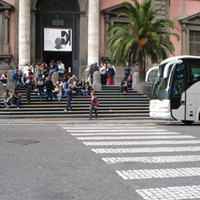Parking Policies in Tourist Cities
Abstract
This article deals with management of tourism mobility particularly referred to urban parking area for tourist buses and cars. This work aim at proposing the realization of an integrated tourist parking network connected with urban supply of services and facilities dedicated to tourist customers. This purpose bases on some general considerations. First of all the awareness that tourism generates direct impacts on urban mobility increasing both the levels of pollution and urban congestion. Secondary the need to integrate management exigencies with objectives of development to maximize positive effects of tourist activity. Parking policies represent an important knot in the mobility planning process and they could have a central role in reducing urban pollution levels. Normally this target is obtained by the introduction of tolls to reach the central area of the city both to discourage car use and to safeguard the more sensitive part of the city. Inner city, in fact, is characterized by a high concentration of urban functions and elements of tourist attraction too. As regard Italian situation, the mobility management at urban level is regulated by Urban Traffic Plan that defines the rules to improve urban traffic, to reduce pollution and to ensure good levels of road safety. Urban Parking Program, instead, is aimed at offering possibility to realize parking infrastructures within the city. This plan has been introduced by law (122/1989) and it referred to different typologies of parking areas. Within this plans, tourist parking areas have a marginal role even though tourist activity is affecting more and more urban policies. In Italian tourist city the actions aimed at regulating urban tourist mobility especially refer to: –establishment of Limited Traffic Zone for tourist buses whose access is permitted against payment of a “tourist bus ticket”; –identification of mooring points for setting down and picking up visitors. Rarely, parking policies refer to individuation of urban zones specifically dedicated to tourist bus parking also in tourist cities. This underlines a lack of integrated planning and policies aimed at optimizing urban supply to reduce the congestion caused by tourist flows. Parking facilities should be built in order to avoid urban congestion problem due to tourist charge. These specific parking areas should be located outside the inner city whose connection should be ensured though: –ecologic tourist shuttle also equipped to give information about visit modalities and tourist attractions; –bike sharing or other sustainable transport modality allowing flexibility in scheduling visit especially for some specific tourist users (i.e. young people, families, students, etc.); –taxi sharing allowing to reach rapidly central zones especially for business tourist; –design of equipped pedestrian and cycling routes to get information or other kind of support services aimed to optimize the visit. Special incentives could be provided for some specific tourist typologies (i.e. students, seniors, families, young people).Downloads

Copyright (c) 2014 Tema. Journal of Land Use, Mobility and Environment

This work is licensed under a Creative Commons Attribution 4.0 International License.
Authors who publish in this journal agree to the following:
1. Authors retain the rights to their work and give in to the journal the right of first publication of the work simultaneously licensed under a Creative Commons License - Attribution that allows others to share the work indicating the authorship and the initial publication in this journal.
2. Authors can adhere to other agreements of non-exclusive license for the distribution of the published version of the work (ex. To deposit it in an institutional repository or to publish it in a monography), provided to indicate that the document was first published in this journal.
3. Authors can distribute their work online (ex. In institutional repositories or in their website) prior to and during the submission process, as it can lead to productive exchanges and it can increase the quotations of the published work (See The Effect of Open Access)
